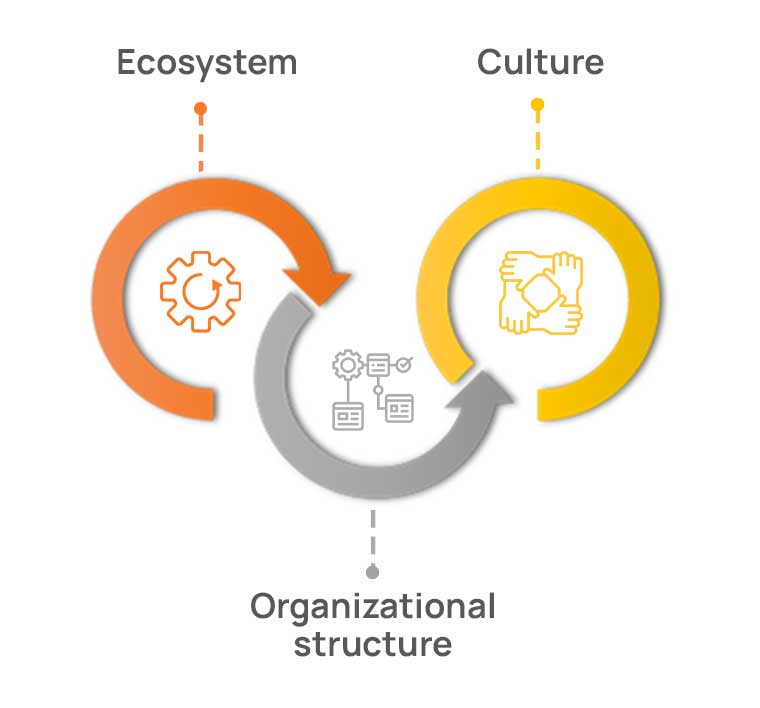Business Intelligence | 10 Dec 2021 | 8 min
The Role of Culture in Innovation in the VUCA World

The COVID-19 pandemic has fuelled a state of rapid change in the market owing to constantly shifting supply and demand cycles. Which inevitably brings me to a significant question in these tumultuous times – What is VUCA? If you are not aware of this new, trending abbreviation, it stands for Volatile, Uncertain, Complex, and Ambiguous. It is pretty much a situation that most enterprises worldwide are currently facing, whether they are big or small. Here is a brief explanation of the acronym:
Naturally, a VUCA world is likely to sap the motivation of individuals and organizations and heighten their anxiety. Considering these effects, innovation and creative thinking have become necessary for enterprises to help them succeed, but at the same time, prioritizing these innovations has become critical and the need of the hour. John F. Kennedy’s observation – “The Chinese use two brush strokes to write the word crisis” – highlights two characteristics composed in a single word–one representing danger and the other representing opportunity. This is particularly true today. While the pandemic has upended nearly every aspect of life – both personal as well as professional – the crisis became an opportunity for many who embraced technology adoption to innovate at both micro as well as macro levels of business, leading to a shift in our way of living.
The objective of this blog is to identify and briefly explore the cultural triggers that support innovation in this ever-evolving VUCA world even within this adverse situation. Over the last four years, I have been studying the industry evolution trends across the manufacturing industry to learn which key common traits help organizations become digital leaders. And, contrary to my belief, I learned that the primary factor for any business or society to transform or stay relevant is not the ability of an organization to invest in technology.
I will try to explain the why for the above statement. Innovation, disruption, and ways of living are closely related to the characteristics of the ecosystem they are part of. For any organization to embrace innovation, it must first establish the right equation and balance among the ecosystem, organizational structure, and culture (comprising factors such as motivation/triggers, skills, and learning). While all these elements stated above are not always easy to analyze, having a model or a framework in place to track and monitor the effect of an individual parameter on the other, is very important.

My observation has been that, for any country to walk the path of transformation considering the societal needs, it would first need to ensure innovation at the micro level supporting personal needs covered by business needs. For all of this to happen seamlessly, it is vital to align the transformation effort with individual values and behaviours, failing which can create additional risks to an organization’s culture, whereas a comprehensive and collaborative effort can help shift the culture to understand, embrace, and advance digital transformation. Several such examples of understanding individual needs and weaving them in country-level transformation are case studies in front of us today i.e., Aadhar as a unique ID for an individual, to UPI.
At the level of an organization, communication in the form of open dialogue that is two-way, multi-level, honest, frequent, and clear, is very important for executive leaders to connect meaningfully with employees across their organization. Regular verification and reinforcement of the mission and intent of digital innovation are equally necessary. It’s worth noting that this crisis has provided a valuable opportunity to help leaders to develop on the job.
Many may debate about its acceptance, but my deep dive has shown similar patterns of ensuring a shift in culture for increased adoption of innovative practices. On a related note, do check out our blog centred on managing business transformation in the VUCA world.

Enterprises that choose to harness digital transformation as a fundamental strategic component for their VUCA business models would have a good chance of steering through the uncertainty and reaching their targets of profitable growth. Write to us to learn more about our services and read our case study that describes how an organization in the Non-Banking Financial Corporation (NBFC) sector adopted a data maturity model for process optimization supported by Nitor Infotech’s strategy & consulting services.

we'll keep you in the loop with everything that's trending in the tech world.
